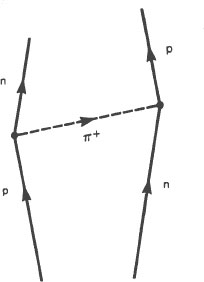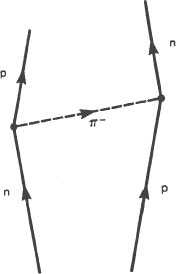The Dancing Wu Li Masters (33 page)
Read The Dancing Wu Li Masters Online
Authors: Gary Zukav

This is the basic Yukawa interaction. The strong force, as Yukawa theorized in 1935, is the multiple exchange of virtual pions between nucleons. The number of the exchanges (the strength of the force) increases at close range and decreases at a distance.
In a similar manner, neutrons never sit still and just be neutrons. Like protons and electrons they also constantly interact with themselves by emitting and re-absorbing virtual particles. Like protons, neutrons emit and re-absorb neutral pions. On the top of the next page is a Feynman diagram of a neutron emitting and re-absorbing a neutral pion.

In addition to emitting a neutral pion, a neutron also can emit a negative pion. However, when a neutron emits a negative pion, it
momentarily transforms itself into a proton! First there is neutron, then there is a
proton
plus a negative pion, then there is a neutron again. Below is a Feynman diagram of this dance which continually changes a neutron into a proton and back into a neutron again.


If a neutron comes so close to a proton that their virtual pion clouds overlap, some of the pions that are emitted by the neutron are absorbed by the proton. Below is a Feynman diagram of a virtual-pion exchange between a neutron and a proton.
This is another strong-force interaction. In the left half of the diagram, a neutron emits a negative pion, temporarily transforming itself into a proton. However, before the negative pion can be re-absorbed, it is captured by a nearby proton which, in turn, becomes a neutron. The exchange of a negative pion causes a neutron to become a proton and a proton to become a neutron. As before, a pair of nucleons, bound together by a virtual-pion exchange, have changed roles.
There are many more strong-force interactions. Although pions are the particles most often exchanged in the creation of the strong force, the other mesons (such as kaons, eta particles, etc.) are exchanged as well. There is no “strong force”; there are only a varying number of virtual-particle exchanges between nucleons.

The universe, according to physicists, is held together by four fundamental types of glue. In addition to the strong force and the
electromagnetic force, there is the “weak” force and the gravitational force.
*
Gravity is the long-range force which holds together solar systems, galaxies, and universes. However, on the subatomic level its effect is so negligible that it is ignored altogether. Future theories, hopefully, will be able to take it into account.
†
The weak force is the least known of the four forces. Its existence was inferred from the times required by certain subatomic interactions. The strong force is so short-range and powerful that strong-force interactions happen very, very fast, in about .00000000000000000000001 (10
-23
) seconds. However, physicists discovered that a certain other type of particle interaction which they knew involved neither the electromagnetic nor the gravitational forces, required a much longer time, about .0000000001 (10
-10
) seconds. They therefore deduced from this strange phenomenon that there must exist a fourth type of force. Since this new fourth force was known to be weaker than the electromagnetic force, it was called the weak force.
In the order of their strength, the four forces are:
Strong (nuclear) force
Electromagnetic force
Weak force
Gravity
Since the strong force and the electromagnetic force can be explained in terms of virtual particles, physicists assume that the same is true of the weak force and gravity. The particle associated with gravity is the graviton, whose properties have been theorized, but whose
existence never has been confirmed. The particle associated with the weak force is the “W” particle, about which much has been theorized, but not much has been discovered.
The range of the strong force, relative to the electromagnetic force, is limited because mesons, relative to photons, have so much mass. Remember that the policeman who enforces the conservation law of mass-energy is willing to turn his back if the violation is quick enough, but the more flagrant the violation, the more quickly it must happen. The momentary creation of a meson out of nothing is a much more flagrant violation of the conservation law of mass-energy than the momentary creation of a photon out of nothing. Therefore, the creation and re-absorption of a meson must happen more quickly to stay within the protection, so to speak, of the uncertainty relation between time and energy. Because the life span of a virtual meson is limited, its range also is limited. The rule of thumb governing this phenomenon is this: The stronger the force, the more massive is the mediating particle, and the shorter is its range. The range of the strong force is only about one ten-trillionth (10
-13
) of a centimeter. Accordingly, the range of the electromagnetic force is much greater than the range of the strong force. In fact, the range of the electromagnetic force is
infinite
. This is because photons
don’t have any rest mass!
“Wait a minute,” says Jim de Wit, agreeing with us for a change. “This doesn’t make sense. A virtual photon is a photon which is emitted and re-absorbed quickly enough to avoid violating the conservation law of mass-energy. Right?”
“Right,” says a particle physicist on his way to the cyclotron.
“Then how can a particle, or anything else, be emitted and re-absorbed within certain time limits, like the time limits imposed by the uncertainty principle, and still have an
infinite
range? It doesn’t make sense.”
De Wit has a point. At first glance it appears that he is correct. On closer examination, however, there
is
a subtle logic involved which
does
make sense. If the limitations of the conservation law of mass-energy are avoided by a balance of time and energy (mass) permitted by the uncertainty principle, and a virtual photon has
no
(rest) mass, then it has all the time in the world, literally, to go where it pleases. In other words, there is no practical difference between a “real” photon and a “virtual” photon. The only difference between them is that the creation of a “real” photon does not violate the conservation law of mass-energy and the creation of a “virtual” photon avoids the law momentarily via the Heisenberg uncertainty principle.
This is a good example of how “unreal” and “ivory-tower-like” the nonmathematical explanation of a successful physical theory can sound. The reason for this is that physical theories, in order to describe more accurately the phenomena under consideration, have become more and more divorced from everyday experience (i.e., more abstract). Although these highly abstract theories, such as quantum theory and relativity, are unaccountably accurate to an awesome degree, they truly are “free creations” of the human mind. Their primary link with ordinary experience is not the abstract content of their formalisms, but the fact that, somehow, they work.
*
The distinction between a transient, virtual (nothing-something-nothing) state and a “real” one (something-something-something) is similar to the Buddhist distinction between reality as it actually is and the way that we usually see it. For example, Feynman himself described the difference between a virtual state and a real state (of a photon) as a matter of perspective.
…what looks like a real process from one point of view may appear as a virtual process occurring over a more extended time.
For example, if we wish to study a given real process, such as the scattering of light, we can, if we wish, include in principle
the source, scatterer, and eventual absorber of the scattered light in our analysis. We may imagine that no photon is present initially, and that the source then emits light…. The light is then scattered and eventually absorbed…. From this point of view the process is virtual, that is, we start with no photons and end with none. Thus we can analyze the process by means of our formulas for real processes by attempting to break the analysis into parts corresponding to emission, scattering, and absorption.
2
According to Buddhist theory, reality is “virtual” in nature. What appear to be “real” objects in it, like trees and people, actually are transient illusions which result from a limited mode of awareness. The illusion is that parts of an overall virtual process are “real” (permanent) “things.” “Enlightenment” is the experience that “things,” including “I,” are transient, virtual states devoid of separate existences, momentary links between illusions of the past and illusions of the future unfolding in the illusion of time.
Particle self-interactions become quite intricate when virtual particles emit virtual particles which emit virtual particles in a diminishing sequence. On the next page is a Feynman diagram of a virtual particle (a negative pion) transforming itself momentarily into two more virtual particles, a neutron and an anti-proton (Dirac’s 1928 theory also predicted anti-protons which were discovered at Berkeley in 1955).
This is the simplest example of self-interaction. On the exquisite dance of a single proton performed in the flicker of time permitted by the uncertainty principle. This diagram was constructed by Kenneth Ford in his book,
The World of Elementary Particles
.
3
Eleven particles make their transient appearance between the time the original proton transforms itself into a neutron and a pion and the time it becomes a single proton again.
A proton never remains a simple proton. It alternates between being a proton and a neutral pion on the other hand, and being a
neutron and a neutral pion on the other hand. A neutron never remains a simple neutron. It alternates between being a neutron and a neutral pion on the one hand, and being a proton and a negative pion on the other hand. A negative pion never remains a simple negative pion. It alternates between being a neutron and an anti-proton on the one hand, etc., etc. In other words,
all particles exist potentially (with a certain probability) as different combinations of other particles
. Each combination has a certain probability of happening.
